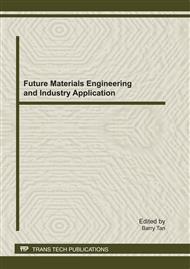p.3
p.8
p.14
p.18
p.23
p.28
p.33
p.38
Prediction of the Deterioration Depth of Concrete by Accelerating Calcium Leaching Test
Abstract:
The concrete is a solid and porous composite materials, when the concrete exposure to moisture environment for a long-term, the pore water will penetrate into concrete cause hydration products leaching. Leaching of calcium ions increase in porosity and resulting in harmful ions ingress into concrete to reduce strength and durability of concrete. The purpose of this study is to evaluate the effect of water-binder ratio on calcium ion leaching behavior of cement-based material. The ammonium nitrate solution was used to accelerate leaching process. Leaching duration was 56 days, 91 days and 140 days, respectively. The leaching depth and compressive strength were measured. The results showed that leaching resistance increased with a decrease in water/binder ratio. The leaching depth showed that leaching behavior of the specimens without minerals admixtures can be divided into two stages, the first stage was leaching of calcium hydroxide and than the C-S-H gel were leaching.
Info:
Periodical:
Pages:
3-7
Citation:
Online since:
October 2011
Authors:
Price:
Сopyright:
© 2012 Trans Tech Publications Ltd. All Rights Reserved
Share:
Citation:


